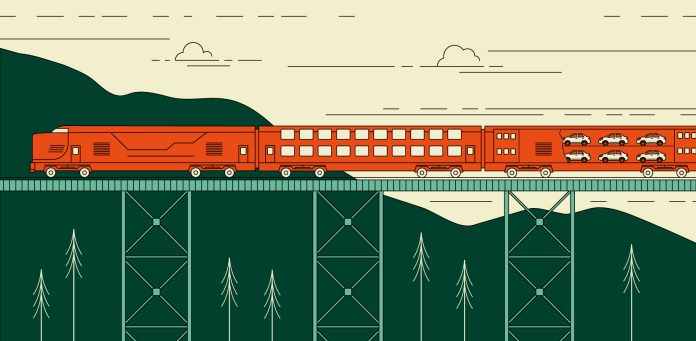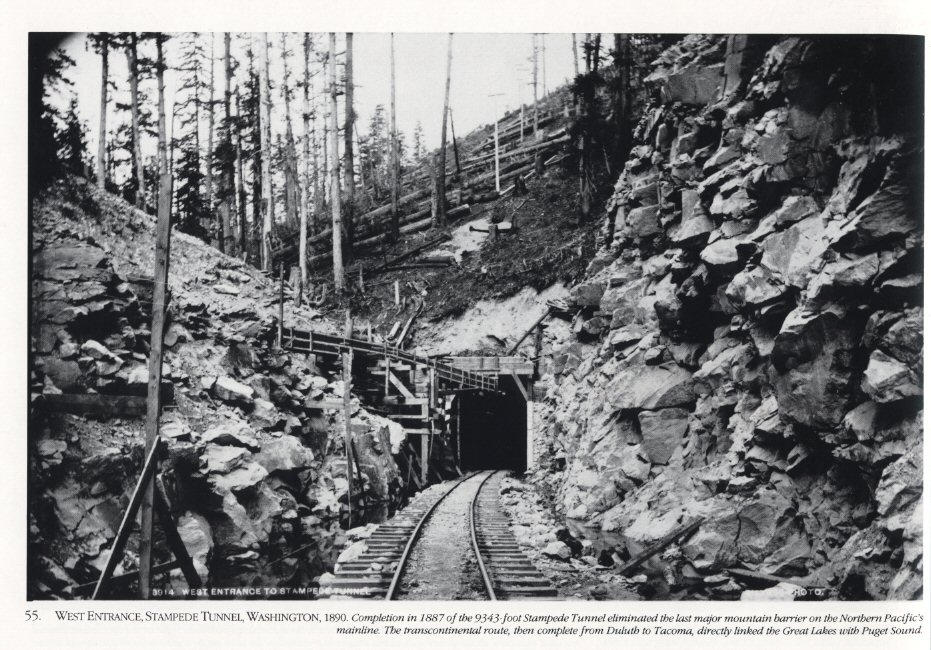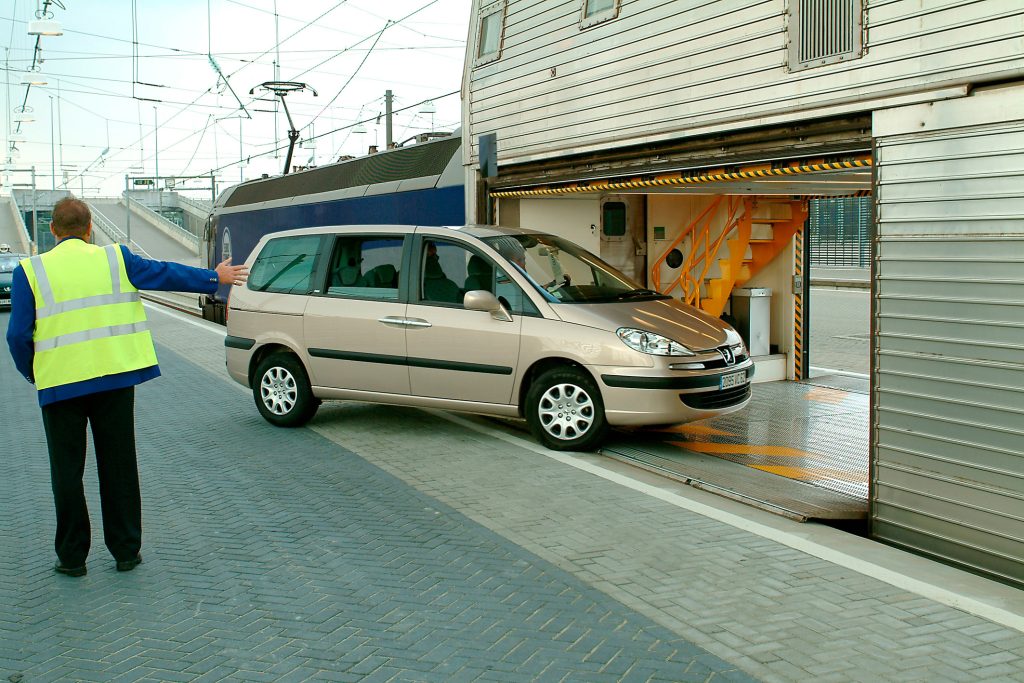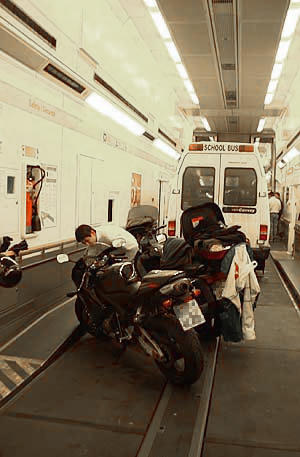
A ferry on rails could help electric cars get across the Cascade Mountains without burning up their battery or sitting in traffic.
In my previous Local Cascades Service article about rebuilding Stampede Pass, I briefly mentioned the idea of a ferry service as one potential use for expanded service. In this article, I will cover in greater detail about what that might look like. A number of obstacles make Stampede Pass passenger rail incredibly unlikely right now in its current state. It’s not fit for two-way travel, the rail is not of passenger grade quality, and the route is long and slow with lots of sharp turns. Additionally, there is not nearly enough demand for passenger travel to justify rebuilding the mountain pass for a single Amtrak route through the mountains, let alone one too slow to be competitive with buses or even Amtrak’s Empire Builder service.
The Real Problem and Big Idea
The biggest problem in getting more rail routes of the Cascades right now is demand. The Cascades tunnel near Highway 2 is too crowded with the lion’s share of cross-state freight, but there is not currently enough extra demand to fund a new pass on its own. There would need to be a big boost of demand for cargo and if at all possible, that cargo ought to be willing to pay a premium to help pay for the construction and make investing in upgrading the rail line in this corridor pay off.
In order to solve these issues, we should try turning the problem on its head. Think of Stampede pass an unpolished asset and of the crowding at other passes as a potential market to serve. Include all passes in the equation and look at what needs they have that are not served. Unlike the other crowded passes, Stampede Pass can be used as a blank slate to build the kind of corridor the future needs — one that could meet our transportation needs and our environmental goals. Stampede Pass should become a modern carbon-free crossing of the Cascade Mountains.
Stampede Pass could be a fully electric, fully grade-separated, high-speed, and potentially automated transportation corridor. It’s the only pass that can never have a highway through it as it hosts a reservoir and bans public access. Rather than this being a drawback, it could be a reason to double down on what is already there. There are no roadways to disrupt or compete with if the rail route is widened or changes course and with basically no stops along the way, there is a lot of room to re-imagine a widened, straightened electrified railway that could (with enough work) reach Rail Class 4 or 5 for consistent speeds of 65 mph to 80 mph for freight and even faster for passengers. The non-stop nature of the route also makes it a potential candidate for automation which could also increase its safe operation speed and capacity.
Remaking Stampede Pass and Build A Ferry on Rails
So, what kind of cargo could fund an electric high-speed freight railway? Certainly, some online retailers may wish to use a carbon-free shipping route to boost their image, but there is a bigger ticket customer that also has a much broader political base. Though it may seem non-intuitive, we might want to take a look at the current non-rail traffic on all of the other passes. Personal cars, freight trucks, and buses currently struggle with the Highway 2 and I-90 crossings of the Cascades. The crossings are frequently crowded, and in the winter they can be challenging to traverse with the need to winterize vehicles. In some cases, they may shut down entirely from avalanches or heavy snow. It’s safe to say that a lot of drivers would be willing to pay a premium to skip this part of the drive or to get through at all when the weather events cause a closure. How would we move auto traffic across a rail only corridor though? It turns out that the solution already exists and is used in many places across the world.
It goes by a few names but whether you call it auto rail, car trains or car shuttles it all boils down to a similar concept. Several interconnected flat rail cars act like a road for cars to drive onto and park. That “roadway” hooks to a train and pulls the load through mountain or sea tunnels. These vehicle-storing rail cars can come in one, two, or three levels and can store various vehicle sizes and configurations. They can be open air or covered and frequently come with a passenger section in the front for drivers to lounge in and enjoy the scenery outside the train. If this sounds a bit like Washington State’s ferry system, that’s because it’s a similar concept.
The car shuttle that travels the Eurotunnel even has an interior that looks a bit like a ferry car deck. While specific numbers are difficult to find, these systems do tend to pull in a good amount of revenue. Amtrak’s Auto Train, for example, is its highest revenue long distance route, generating $81.6 million in 2016 alone. In the case of Stampede Pass, the route would be relatively short but high value as it crosses a difficult mountain range. In this sense it would operate a bit more like Eurotunnel or the various versions found in Europe. A rail-based pass built new to stay open in the winter could provide relief folks need to get across the state while providing a fun, carbon-free way to experience the mountains year-round.
Mobile Charging Port and Transit
Though the idea of getting a vehicle across the mountains without having to drive could be a decent selling point on its own, with a little effort this could be particularly attractive to drivers of electric vehicles. One of the major drawbacks to lower cost electric vehicles is the relatively low range they can support on a single charge. Fortunately, many of these cars also feature a rapid charger which could bring the vehicle close to fully charged in under an hour. Equipping the cross mountain ride with car chargers could both provide a double boost in range by removing drive time from mountain traffic and allowing the vehicles to arrive at their destination close to fully charged. This kind of service could help accelerate the acceptance of electric vehicles and might even attract investment in this project by electric vehicle manufacturers. (Thanks to Oran Viriyincy for assisting with this idea.)
Now this may seem that all of this has been about how this project could benefit drivers, but like ferries, these trains ought to be equipped with a decently sized passenger section so folks who want to cross the mountains via transit can do so. Cle Elum and its nearby villages could be an interesting tourism opportunity unto themselves, but if the valley train line I proposed is built, riders could easily transfer at that point. Additionally, these trains could carry several intercity buses over the pass, which could then immediately drive off directly to popular destinations that it would be difficult to serve with a single train line (e.g., Spokane, Wenatchee, Chelan, and Walla Walla). Finally, once Stampede Pass is a speedy (60 mph to 90 mph) electrified rail corridor, running one or two daily rail express trains from Seattle to the Tri-Cities region would be a much more reasonable proposition.
The ferry idea is an attention-grabber, but it’s also something real that we could build. Trains could carry a lot of cars, but it is true that capacity would be roughly similar as Washington’s current auto carrying ferries. Similar to the ferries, a big restriction on capacity will be loading and unloading the trains which does not scale well the more cars you stack. It would be worth carefully studying how existing car trains operate to find an optimal pattern. The benefit of a relatively short route (one to two hours after upgrading the route) is that trains don’t necessarily need to be overflowing with cars as multiple trips could be made. More importantly, this service would focus upgrades on the most problematic part of the Stampede Pass route: the mountain itself. The kind of capacity and speed improvements would also create a lot of new capacity other kinds of high-speed freight.
Building It, Paying for It, and Political Support
Clearly the parties interested in building this venture would need to do a full study to find financially viable ways to make this happen, but here are a few suggestions to get started. First building the planned commuter rail to Southeast King County as an electric, double-tracked rail line would provide a good starting point for joint investment. In some areas it may make sense to build a new route just for the freight route, and in those cases it could make sense to devote the old track to the commuter line. Building the commuter light rail (EMU) would also help bring in local community support for the overall project.
Past Ravensdale there are very few homeowners to deal with, but there might be some environmental opposition and the costs will go up simply because there is a lack of safety infrastructure and the turns are often super sharp. Straightening and widening the route will likely require more tunnels and bridges and a significant investment would be needed for adding signals. Getting initial speeds up to roughly Class 4 rail (60 mph) with an eventual goal some sections at Class 5 (80 mph for freight) would be a good target. Anything faster would require very deep, long tunnels that would probably take over a decade to complete. Even an average speed near 60 mph would be roughly 2.5 times the current average speed which would cut travel time from about three hours to nearly one hour. Terminal locations seem to make the most sense if they are adjacent to a Burlington Northern Santa Fe (BNSF) rail yard and a major highway or freeway. This is why Auburn near SR-18 and Cle Elum near I-90 seem like a natural fit.
This will no doubt be a big project and require deep pockets to get it off the ground. It ought to involve BNSF, Washington State Department of Transportation (WSDOT), the federal government, and potentially private investors. It has a lot of points that could interest all parties. An electric freight and passenger pathway has a lot of potential environmental benefits and fits well with the stated federal plan to reduce carbon emissions. BNSF has an interest in improving the value and potential flow of customers through its underutilized mountain route. WSDOT could invest in additional mountain route capacity to act as a relief valve for the existing road routes, and their expertise in running ferry routes could come in handy. Private investors might also like the cache of providing carbon-free freight routes which they could use in the state’s newly passed carbon cap and trade system or simply as good public relations. Even freight truck companies may have some interest as it represents a way to reduce fuel use and have more rested drivers on cross mountain services.
This project could potentially develop a pretty wide political base of support. Counties on both sides of the Cascades would directly benefit from a new path across the mountains. The large number of voters who drive cars all over the state could easily see this as something they could use. Transit advocates could appreciate a new passenger way to get across the mountains (attached to a freight system) and environmental groups that want to advance electrification might also see this as worth supporting. City leaders in Southeast King County could get the light rail line they’ve been wanting, Kittitas County could increase its tourism trade with more ways to reach its mountain towns, and valley residents would have a nice connection to their potential train line and could have better access to Seattle.
Stampede Pass, as it is today, needs a lot of improvements to make it a viable way to travel. It’s a long, windy route and is missing a lot of infrastructure. This relatively raw state and its relative isolation from urban sprawl presents a decent opportunity to remake it as a high-speed, electrified, and potentially automatic freight and passenger corridor of the future. The trick is to get enough paying freight traffic to make this a viable plan. To this, we offer the idea of an electrified high-speed ferry service (or a car shuttle train) which has seen applications in countries all over the world. In addition to other services seeking low carbon transport, this could provide the financial and political incentive to build a new, environmentally-friendly mountain pass. The first such modern cross mountain connection in the United States. This idea may seem a bit crazy to some, but we are going to need out of the box ideas to meet the challenges of the 21st century.

Charles Bond
Charles is an avid cyclist that uses his bike as his primary mode of transportation. He grew up in the Puget Sound, but is currently overseas living in Japan. He covers a range of topics like cycling, transit, and land use. His time in Tokyo really opened his eyes to what urbanism offers people and has a strong desire to see growth happen in Seattle.






